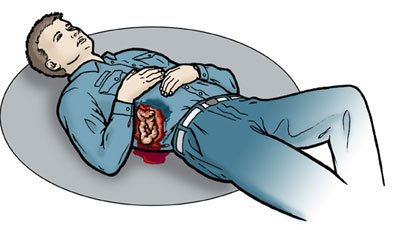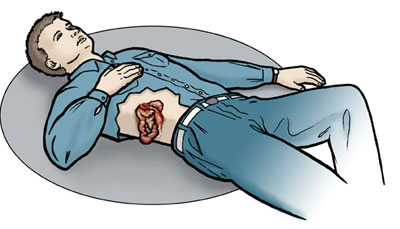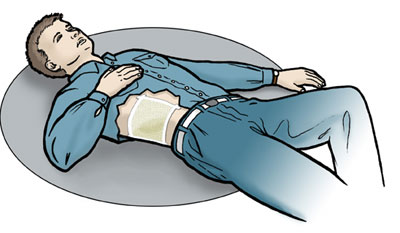

Anatomy of First Aid: A Case Study Approach
Ronald Bergman, Ph.D.
Peer Review Status: Internally Peer Reviewed
A Sailor, on liberty in a foreign port, was returning to his ship when a knife-wielding assassin attacked him. He later remembered that he was slashed, but was able to chase his assailant away, before he collapsed. Two of his shipmates found him, and when it was clear that the injury was severe, one of the shipmates was sent to get the ship's corpsman.
The attending shipmate was familiar with "first aid" and set about initial care to reduce the possibility of severe shock. The injured Sailor had regained consciousness and was rational and was told not to stand up. He was covered with his shipmate's jacket and his feet and legs were elevated. His vital signs were satisfactory; pulse was regular (between 60 and 90 beats per minute); breathing rate acceptable (about 15 to 20 per minute), and his blood pressure pulse was judged, in the absence of a pressure cuff, to be strong.
The corpsman on duty and the other shipmate quickly returned from the ship. The corpsman took over responsibility for first aid and examined the wound. He cut away the Sailor's shirt to expose the abdominal wound and found that his intestines were protruding from the wound. Although bits of the Sailor's shirt were adhering to the intestines they were not removed. The corpsman told his shipmates that the intestines must not be touched and no attempt must be made to replace the intestines back into the abdominal cavity as part of first aid. This is to be performed in sickbay by the naval surgeon. The corpsman carefully covered the wound with a sterile moist gauze bandage taped to the abdomen.
The corpsman contacted the ship's duty officer to obtain a stretcher and to alert the medical officer that a severe abdominal wound was on the way to the ship for surgical treatment. When the stretcher arrived, the four Sailors carefully placed the injured Sailor on the stretcher and transported him safely to sickbay for definitive medical care aboard ship.



Please send us comments by filling out our Comment Form.
All contents copyright © 1995-2025 the Author(s) and Michael P. D'Alessandro, M.D. All rights reserved.
"Anatomy Atlases", the Anatomy Atlases logo, and "A digital library of anatomy information" are all Trademarks of Michael P. D'Alessandro, M.D.
Anatomy Atlases is funded in whole by Michael P. D'Alessandro, M.D. Advertising is not accepted.
Your personal information remains confidential and is not sold, leased, or given to any third party be they reliable or not.
The information contained in Anatomy Atlases is not a substitute for the medical care and advice of your physician. There may be variations in treatment that your physician may recommend based on individual facts and circumstances.
URL: http://www.anatomyatlases.org/